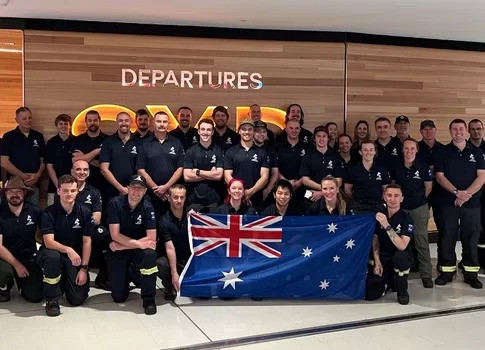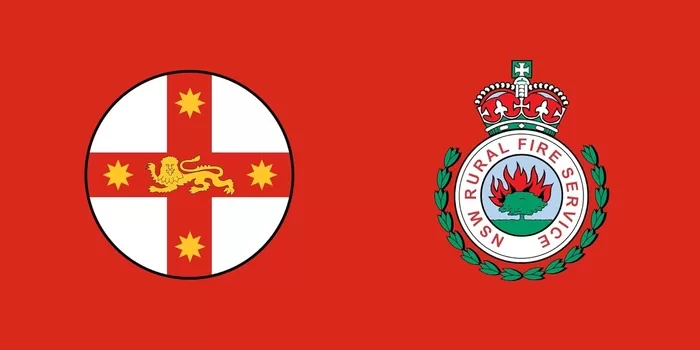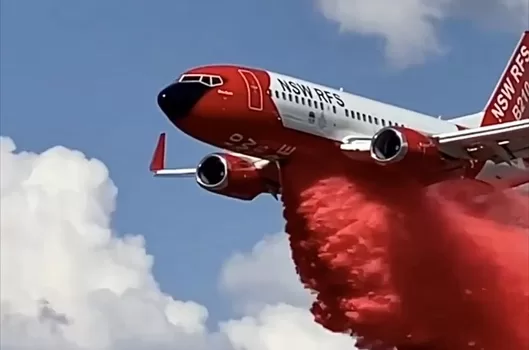Wildfires are a natural disaster that know no borders. As climate change intensifies, the frequency and severity of these fires have increased, posing significant challenges to affected regions. In response, a remarkable system of international cooperation has developed, enabling the exchange of volunteer firefighters between North America (Canada and the USA) and Australasia (Australia and New Zealand).
This cross-continental collaboration plays a crucial role in combating wildfires and fostering global solidarity among firefighting communities. Whether you call them wildfires in North America or bushfires down under, the global problem of natural disasters requires a global solution.
Advertisement:
Exchange of Volunteer Firefighters Between North America and Australasia in the Fight Against Wildfires
The Necessity of International Cooperation
Wildfire seasons in the Northern and Southern Hemispheres occur at different times of the year due to the opposite seasonal cycles. When it is summer in North America, it is winter in Australasia, and vice versa.
This seasonal difference allows for an efficient exchange of firefighting resources, as firefighters from one hemisphere can assist their counterparts in the other during peak fire seasons.
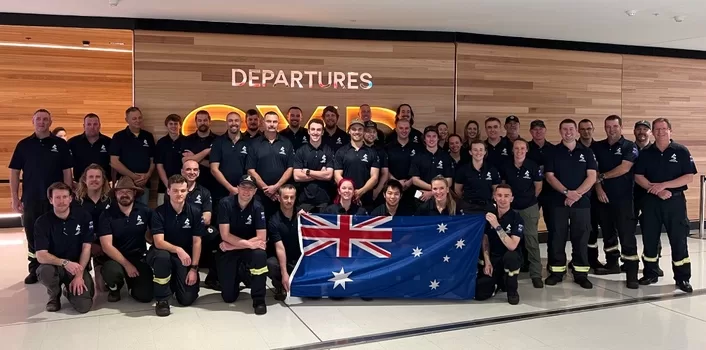
On 28 July 2024, a contingent of NSW firefighters departed for Canada. 21 firefighting specialists from NSW include 10 firefighters and a deployment manager from the Rural Fire Service (RFS), and 10 from National Parks and Wildlife Service.
With 116 personnel already operating in Alberta, this latest contingent will take the total number of Australians and New Zealanders deployed to 218.
Australian firefighters already in Canada this season are primarily undertaking incident management and specialist aviation duties, while this delegation is made up of arduous firefighters who will provide much needed relief for their Canadian colleagues on the ground.
This cooperation is essential for several reasons:
- Resource Augmentation: Wildfires can stretch local resources to their limits. By bringing in additional manpower and expertise from other countries, affected regions can bolster their firefighting capabilities.
- Skill Sharing: Firefighters from different regions bring unique skills and experiences. The exchange programs facilitate the sharing of best practices, techniques, and strategies, enhancing the overall effectiveness of wildfire management.
- Solidarity and Support: The exchange fosters a sense of global solidarity. Firefighters often risk their lives to protect communities, and knowing that their international peers are ready to assist can be a significant morale booster.
The Mechanics of the Exchange Program
Selection and Training
The exchange of volunteer firefighters is a highly organized process. Firefighters from Canada, the USA, Australia, and New Zealand undergo rigorous selection and training programs to ensure they are prepared for the unique challenges of international deployments. These programs include:
- Physical Fitness Assessments: Ensuring firefighters are in top physical condition to handle the demanding nature of wildfire suppression.
- Technical Training: Covering aspects such as fire behavior, suppression techniques, and the use of specialized equipment.
- Cultural Sensitivity Training: Preparing firefighters for the cultural differences they may encounter while working in a foreign country.
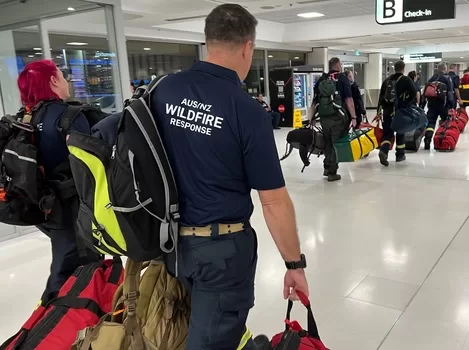

Deployment and Integration
When a country experiences a severe wildfire season, requests for international assistance are made through established protocols.
Firefighters are then deployed in teams, often composed of members from multiple countries.
Upon arrival, they are integrated into local firefighting operations, working alongside their counterparts in various capacities, including frontline firefighting, logistical support, and incident management.
Success Stories and Challenges
Australian Bushfires
During the catastrophic 2019-2020 Australian bushfires, firefighting aircraft from North America were deployed to assist. Notably, the DC-10 air tanker, known as “Southern Belle,” was sent from the USA to help contain the fires.
These aircraft played a pivotal role in dropping thousands of liters of water and fire retardant, significantly aiding firefighting efforts.
During the devastating bushfire season, over 300 firefighters from Canada and the USA were deployed to Australia. Their efforts were instrumental in containing several major fires and providing much-needed relief to exhausted local crews.
North American Wildfires
In 2018, severe wildfires in California prompted the deployment of Australian and New Zealand firefighting aircraft to the USA. These aircraft, including water bombers and helicopters, provided crucial aerial support, helping to contain the fires and protect communities.
In response to the catastrophic fires in California, Australian and New Zealand firefighters were deployed to assist. Their experience with large-scale wildfires in Australasia proved invaluable in combating the fires.
Challenges
Despite the success, the exchange program faces several challenges:
- Logistical Coordination: Deploying firefighters across continents requires meticulous planning and coordination, including travel arrangements, accommodation, and integration into local operations.
- Health and Safety: Firefighters are exposed to hazardous conditions, and ensuring their health and safety is paramount. This includes addressing potential health risks such as exposure to smoke and physical injuries.
- Cultural and Operational Differences: Adapting to different firefighting cultures and operational procedures can be challenging. Effective communication and mutual respect are crucial for overcoming these differences.
Exchange of Firefighting Aircraft
The exchange of firefighting aircraft, such as water bombers, between North America and Australasia is a vital component of international wildfire management cooperation. These aircraft provide essential aerial support, enhancing the capabilities of ground crews and significantly contributing to the containment and suppression of wildfires.
The Role of Aerial Support in Wildfire Management
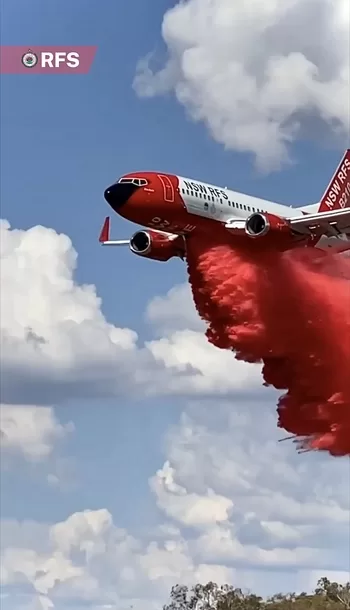

Aerial firefighting resources, including water bombers, helicopters, and air tankers, are critical in combating wildfires, especially in hard-to-reach areas. They perform various tasks, including:
- Water and Retardant Drops: Dropping large quantities of water or fire retardant to slow the spread of fires and protect critical areas.
- Reconnaissance and Surveillance: Monitoring fire behavior and mapping fire perimeters to inform ground operations.
- Transport and Logistics: Moving personnel, equipment, and supplies to and from fire sites.
Mechanisms of Aircraft Exchange
Bilateral Agreements and Requests
Countries have established bilateral agreements that facilitate the rapid deployment of firefighting aircraft when needed. These agreements outline the terms of the exchange, including the types of aircraft, deployment procedures, and financial arrangements.
For example, Australia has agreements with Canada and the USA to request aerial support during peak wildfire seasons.
Deployment and Integration
When a severe wildfire outbreak occurs, the affected country can request aerial assistance through established protocols. Once approved, aircraft are deployed and integrated into local firefighting operations. This integration involves:
- Coordination with Local Authorities: Ensuring seamless collaboration between international aerial resources and local ground crews.
- Briefing and Training: Providing briefings on local fire behavior, terrain, and operational procedures to international crews.
- Maintenance and Support: Ensuring aircraft are well-maintained and supported throughout their deployment.
Challenges and Considerations
Logistical Coordination
Deploying firefighting aircraft across continents requires meticulous logistical planning. This includes arranging for the transport of aircraft, securing necessary permits, and ensuring adequate maintenance and support infrastructure at the destination.
Cost and Funding
Operating and maintaining firefighting aircraft is expensive. The financial arrangements for these exchanges often involve cost-sharing agreements between the participating countries. Ensuring sustainable funding for these exchanges is crucial for their continued success.
Adaptation to Local Conditions
Firefighting aircraft and crews must adapt to the unique conditions of the regions they are deployed to. This includes understanding local fire behavior, terrain, and weather patterns, which can differ significantly from their home regions.
The Future of Firefighter Exchange Programs
The exchange of volunteer firefighters between North America and Australasia is a testament to the power of international cooperation in addressing global challenges. As wildfires continue to threaten communities worldwide, strengthening these exchange programs will be vital. Future initiatives could include:
- Enhanced Training Programs: Developing more comprehensive training programs that focus on the specific challenges of international deployments.
- Technological Integration: Leveraging technology to improve coordination and communication between international firefighting teams.
- Policy Advocacy: Encouraging governments to support and fund these exchange programs to ensure their sustainability.
The exchange of volunteer firefighters between North America and Australasia is a beacon of hope in the fight against wildfires. By sharing resources, skills, and solidarity, firefighters from different corners of the globe come together to protect lives, property, and the environment.
This collaboration not only strengthens firefighting capabilities but also reinforces the bonds of global community and mutual aid.
As wildfires continue to pose significant threats globally, strengthening these exchange programs and ensuring adequate logistical, financial, and operational support will be crucial for building a resilient and effective international firefighting response.
Related stories
NSW RFS Aviation Fleet, NSW Rural Fire Service
Integrating Indigenous Knowledge into Bushfire Management
NSW Rural Fire Service Aircraft Fleet
Mistake State Forest: A Battle for Preservation
Targeted Logging Threatens Great Koala National Park
Replacing timber power poles saves our forests
Advertisement:


